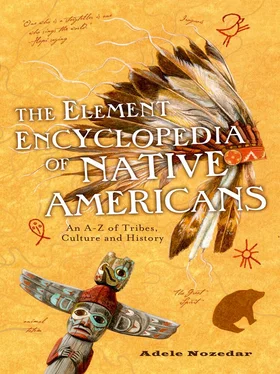“ … Meeting wth ye Sachem [the tribal leaders] the[y] came to an agreemt and buried two Axes in ye Ground; which ceremony to them is more significant & binding than all Articles of Peace the Hatchet being a principal weapon wth ym.”

A word with Arawakorigins ( Kasseque ), a cacique is another name for a chief or a head of a tribe and applies in the main to South American tribes as well as those of the Caribbean. Some Pueblopeople applied the word to their spiritual leaders.
This tribe originated in the Red River part of Louisiana, but moved to the Southern Plains area, following the great herds of buffalo, where they became buffalo hunters as well as horsetraders. Caddo Indians were recognizable by their dark complexion, their pierced noses and nose rings, and tattoos. They lived in tall, elegantly conical houses made of a wooden framework covered in grasses and reeds. These houses looked a little like an elongated bee hive. Unusually, the Caddoans had furniture such as beds and chairs inside their houses, which possibly made the early Spanish explorers well-disposed toward the tribe. The Caddoans also had a covered house for winter, and a house with open sides and a ventilated raised flooring area for the hot summers.
The white men referred to a “Caddo confederacy” which encompassed the Kichai, Tawakoni, Waco, and Wichitapeoples. During the Civil War the Caddo tribes stayed loyal to the Union Government and escaped to Kansas to seek sanctuary. Because of their loyalty, in 1902 each tribal member was accorded citizenship of the United States.
The Caddo were a farming tribe, raising corn, beans, and squash in large clearings which they made in their forests. The tribe was split into two main groups. The Kadohadacho lived along the Red River in what is now the Oklahoma/Arkansas border. The other group were called the Tejas Caddo. The town Nagadoches is actually built on the site of one of the most ancient Tejan settlements. The word Tejas became “Texas” and, in the Caddoan tongue, means “those who are our friends.”
Other tribes spoke almost the same language as the Caddo, including the Wichita and the Pawnee. At one point, all these separate groups belonged to one tribe; their collective myths suggest that at one time all these tribes originated in Arkansas.
The pine forests of eastern Texas have a consistent annual rainfall and a temperate climate, which meant that it made for good farming land. Another advantage for agriculture were the many rivers, streams, lakes, and swamps that could be used to irrigate the land. The woods provided useful hardwood trees, too, and the Caddoan diet was supplemented with nutritious nuts from pecan and walnut trees as well as acorns from the oaks. The Bois de Arc tree was also important, since its tough and springy texture was perfect for making bows. Fortunately for the Caddoans, their territory had the only supply of this particular timber, so they were able to trade these specialist bows with other tribes.

A way of marking the passing of time, a calendar stick was notched or marked in such a way that it would act as a reminder of prominent events in the history of a tribe.
See also Winter Counts
The origin of this word is French, from chalumeau , originally referring to the reeds that were used to make pipes, and later coming to mean “pipe stem.”
Most people are familiar with the concept of the so-called Peace Pipe, the ceremonial pipe that’s passed around the circle of tribal members in a sun-wise direction, the tobaccoshared and smoked as a symbol of concord, or to seal a treaty or pact. Although the ceremonies involving the smoking of a pipe extend far beyond this particular use, the pipe itself is known as the calumet. The pipe used by the Native Americans in Canada was first seen by the French settlers from Normandy, and that’s the name they gave it. “Calumet” now refers, in general, to the highly decorated ceremonial Native American smoking pipe.
A specific type of mineral—called pipestone, pipeclay, or alternatively catlinite after the great painter and explorer George Catlin—is commonly used to make the bowl of the calumet. The catlinite is easy to work, since it has a claylike texture and friability. The importance of this pipe clay is evidenced by the fact that the quarries where the stone is found—in particular the great pipestone quarries in Minnesota—have generally been accepted as neutral territory by warring tribes. Stone from this quarry has been mined and used by the Native peoples to make pipes and other artifacts for at least 3,000 years.
The Lakotapeople believed that the pipe and its smoke formed a bridge between the world of man and the world of spirit, and therefore another very important aspect of the pipe is the material that’s smoked in it. The smoking mix varies from region to region and from tribe to tribe, but in all cases the smoke created by these sacred herbs was believed to carry the prayers, thoughts, and good wishes of the smoker up to the heavens. Often, various herbs were blended together; this is traditionally called kinnikinnick, meaning “mixture.”
The pipes themselves are ornamented in accord with their sacred status, decorated with beading, fur, hair, quills, feathers, and carvings.
The pipe has been described as a “portable altar,” and using the object is carried out with a great deal of ceremony and respect.
Also known as the “Shell Indians,” the Calusa originally lived on the southwest coast of Florida and controlled most of the area. The name Calusa means “fierce ones,” and by all accounts they were a warlike people who caused alarm among the smaller tribes in Florida. The early Spanish explorers, too, became the target for attacks by the Calusa, who were one of the first Native American peoples encountered by the Spanish in around 1513.
Living along the coast and inland waterways, the Calusa constructed houses on stilts with palm frond roofs and no walls. They did not need to farm, but could subsist entirely on the food they found along the waterways. Skilled fishermen, the Calusa made nets from palm and used them to catch catfish, mullet, and other fish. They made spears with which to catch eels and turtles, and also hunted for small game including deer. Children learned from an early age how to catch various shellfish. Sailing, too, came naturally to the Calusa, as did boat-building. Cypress trees, hollowed out, made dugout canoeswhich were able to travel long distances, even as far as Cuba. The canoes were also used to scavenge the shores for booty from shipwrecks, and from which to stage attacks on other tribes.
The Calusa, like most other Native American peoples, were incredibly skilled at adapting any resources that came their way, and, living as they did by the water, shells provided an abundant natural material. They used shells as utensils and in weaponry (including spear tips) as well as for ornamentation and in ritual use. The shells were also used in mound-building. These shell-and-clay constructions are now under the preservation of environmentalists and historians. The artifacts that have been found there are considered an important indication of how the Calusa lived, and are preserved in museums.
Читать дальше














